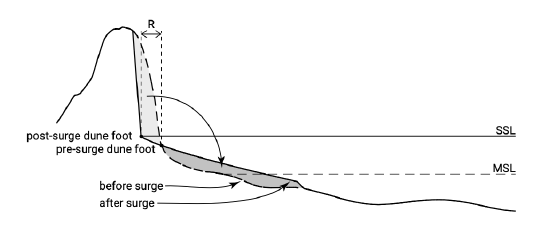10.3.2: Beach and dune erosion during severe storm surges
- Page ID
- 16429

Coasts, which over a number of years seem to be stable, may suffer from the effects of severe storm surge events. During a severe storm, sediments from the dune and upper parts of the beach are eroded and deposited in deeper water within a short time period. This is a typical cross-shore sediment transport process. Severe storms are usually accompanied with higher water levels and higher waves. Under normal conditions the shape of a cross-shore profile might be considered to be in equilibrium with these normal conditions (cf. Sect. 7.2). During a storm, the initial profile shape (viz. the pre-storm profile) is far from the equilibrium shape that corresponds to the severe storm conditions. As a result, processes occur to reshape the profile, causing erosion of the upper part of the cross-shore profile, while the foreshore is accreting, resulting in flatter slopes of the post-storm profile (Fig. 10.5). Note that the control volume does not change during the storm surge. This is because no sand is lost from the profile; sand is merely redistributed in the cross-shore direction. During the storm, while the profile flattens, the erosion process slows down. After the storm, generally a recovery towards the original situation occurs under the combined action of moderate waves and wind (the latter resulting in aeolian transport rebuilding the dunes).
These episodic events do occur along all types of coasts (along structural eroding, stable and even along accreting coasts). As mentioned in the previous section, the rate of erosion can be very high (of course depending on the actual conditions, erosion rates of several metres per event, say per day or days). Associated with the loss of volumes of sediment from dune or firm land, a retreat \(R\) of the coast (see Fig. 10.5) of many metres may occur during a single event. Nowadays methods are available to reliably quantify the rate of dune erosion during arbitrary boundary conditions (see Sect. 7.3.5).

The effects of structural erosion or temporary storm-induced erosion on properties built too close to the shoreline are eventually the same. In both cases, the properties may be lost (see Fig. 10.6). However, it is beyond doubt that countermeasures to resolve or mitigate these different types of erosion must be quite different (see Sects. 10.5.1 and 10.6.1).


